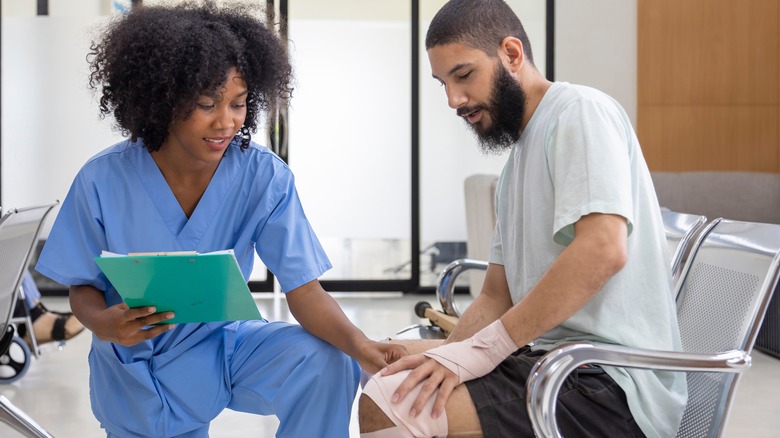How To Get The Most Out Of Your Workout When You Have Tendinitis
If you've ever had tendinitis, you know how it can wreck your workout plans. Tendons take a lot of beating from us, especially if our favorite sports include repetitive movements such as golf, tennis, or running (via Mayo Clinic). Tendons attach muscles to our bones, and they can become inflamed if we put too much stress on them before they're ready. According to GMB Fitness, tendinitis can occur if the muscles strengthen quicker than the tendons can adapt, such as when someone takes steroids.
The most common places tendinitis where occurs are the shoulders, elbows, wrists, knees, and heels, according to the Mayo Clinic. You could try ignoring the pain of tendinitis, which might make it worse. Tendinitis can develop into tendinosis, where the tendon significantly weakens, and fibers thicken and scar (via Baptist Health). If you're not careful with your tendinitis, you could be at risk for tendinopathy, which is when the tendon tears (via Merivale Hand Clinic). Therefore, it's best to take it easy on the area that has tendinitis so that your body can heal. However, this doesn't mean that you have to skip your workouts altogether (via Merivale Hand Clinic).
Working out with tendinitis
According to the Merivale Hand Clinic, you'll probably need to modify your current workout to avoid putting too much stress on the inflamed area. If you're experiencing tendinitis somewhere in your upper body, use this time to work more on your lower body. You can also focus more on cardio so that you circulate some new blood to the affected area to promote healing. However, you'll want to avoid rowing machines or any cardio equipment that requires you to grip (via Merivale Hand Clinic).
If your tendinitis is in the lower body, such as Achilles tendinitis, Sutter Health suggests spinning, swimming, or yoga to ease the pressure on the lower body. You can also work on improving your technique and range of motion for your sport by stretching (via Mayo Clinic).
If you enjoy lifting weights but have tendinitis, Muscle & Fitness suggests warming up the body for 10 minutes before hitting the weights. You'll also need to do plenty of warm-up sets. Your main sets should be with significantly lighter weights and slower movements. If a movement causes pain, you'll want to stop. If your tendinitis is severe, Muscle & Fitness suggests taking a week off.
When to return to your normal routine
The Jacksonville Orthopaedic Institute says you can resume training when you no longer feel tendinitis pain. You should be able to gently stretch the affected area without pain. Rather than resume your workouts quickly, gradually introduce stress back into your affected joint.
What's also helpful in your recovery process is understanding what caused your tendinitis, according to Sports MD. Take a look at your training schedule to see if you suddenly increased the frequency of your workouts or increased your overall training load. It's also a good idea to check your form in your workout or sport. It's possible that your mechanics might have caused tendinitis. According to GMB Fitness, use your recovery time to train your range of motion so that your muscles work more efficiently as they move.
The Mayo Clinic suggests cross-training, stretching, and strength training to help prevent tendinitis. You can also prevent tendinitis by easing up activities — particularly repetitive movements — that overly stress your tendons.



